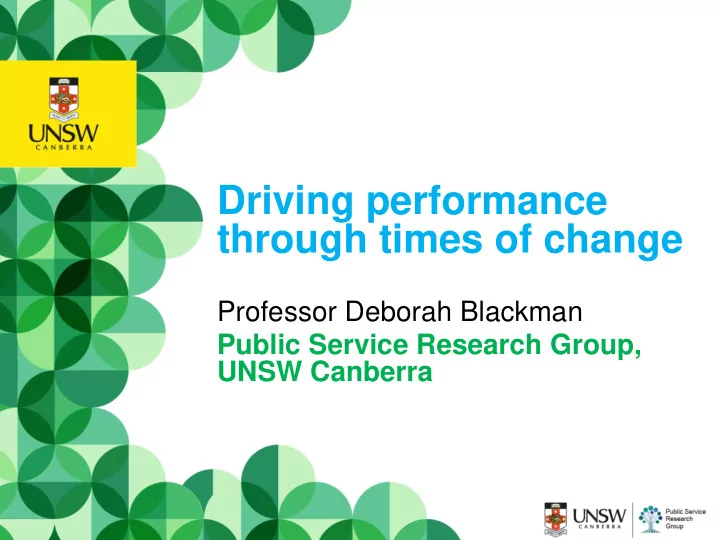

Driving performance through times of change Professor Deborah Blackman Public Service Research Group, UNSW Canberra
Overview • What is change and why does it fail • Why link performance and change management • Presenting conversational types • Learning from the projects • Conclusion
Performance Management … a mechanism that underpins and integrates other management practices
Why is High Performance so hard to attain ❑ Multiple perspectives ❑ Expectations ❑ Experience ❑ Communication styles ❑ Who knows what it looks like ❑ and more
How does culture grow Culture Identify Norms Behavior Reward
Or? Identify Behaviour Culture Reward Norms
Or?
Characteristics of High Performing Organisations ❑ Strategic Orientation and individual role clarity ❑ Outcome and Citizen Orientated ❑ Cooperative Partnerships ❑ Capabilities and Competences ❑ High Employee Engagement ❑ Ongoing feedback ❑ Management of expectations ❑ Continuous Learning and Improvement ❑ Vertical and Horizontal System Alignment ❑ Walking the Talk
A Framework for High Performance • Strategic orientation • Outcome and citizen High Performance Practices orientated High Performance • Cooperative Governance • Dynamic Capabilities and Competences • High Employee High Performance engagement • Adaptable Organisation • Continuous feedback and Improvement • Managing expectaions High Performance • Vertical and horizontal Group system alignment • Walking the Talk High Performance Individual
A Framework for High Performance
What is Change? • To make the form, nature, content, future course, etc., of (something) different from what it is or from what it would be if left alone • To become different or undergo alteration What matters about these definitions?
Perspectives of Change ❖ Structural-functionalism: ‘the job of change agents is to align, fit or adapt organizations, through interventions, to an objective reality that exits “out there”’ (Ford, 1999). ❖ Constructivism: ‘knowledge comes from the interaction of information with the context in which it is presented and … the individual’s pre- existing knowledge’ (Ortony, 1993).
Perspectives of Change ❖ A constructionist world is different from that of structural-functionalist in that a change is not a discrete entity that can be described and identified. Instead, it can be seen to be a series of conversations organised around a particular theme. ❖ ‘ It is more like experimental theatre, in that the script is being written while the play is being performed’ (Ford, 1999, p. 492).
Why Link Change to Conversations? ❖ Organization as a network of conversations interacting to creating reality for individuals. ❖ Performance conversations can support the development of new realities. ❖ Failure to perceive conversations as central to organisational change may contribute failure.
What do conversations need?
No Shared Understanding Person 2 Person 1
Shared Understanding Person 1 Person 2 Shared Understanding
Changing the conversation How do we change a conversation? What do you want to be different? What might it look like if it works?
Types of Conversation ❖ Initiative: start changes, act as a new input or stimuli to the mental models, explain why, triggering ideas and suggesting the need for alternatives. ❖ Understanding: develop awareness and shared mental models of concepts and ideas. ❖ Performance : generate action, clarifying what will be different. ❖ Closure : provide completion, sustain changes made.
Types of Conversation – Applied to the Performance Management Process Initiative Organisational Level: Senior managers determine why doing PM in terms of the required changes. Sets the capabilities required Individual Level – Frame the conversation as a high performance setting. Be prepared based upon the organisational understanding and desired capability developments
Types of Conversation – Applied to the Performance Management Process Understanding Organisational Level: Senior Managers share the direction they are setting with those who actually do PM and develop indicators based on the change outcome Individual Level : Use the PM conversation to develop a shared view of what needs to be different and how it aligns to the desired change
Types of Conversation – Applied to the Performance Management Process Performance Organisational Level: Implement and Evaluate PM strategically linked directly to the desired change Individual Level: Developing and evaluating on going targets through regular conversations Conversations first, forms second
Types of Conversation – Applied to the Performance Management Process Closure Organisational Level: Evaluate the change in capability: talking to middle managers AND look at the analytics. Start new plan Individual Level: Review targets and discuss new behaviours. Seek positive stories for them and from them to help frame the future
Five Most Important Things I Have Learnt • Need to know why you are doing it • Need to know why you are doing it • Need to know why you are doing it • Need to know why you are doing it • Need to know why you are doing it
Five Most Important Things I Have Learnt • Strategically underused – link to change • Needs to look at High Performance primarily • Management not HR must drive PM so the conversations are valuable • PM needs to be seen as core business with ongoing conversations • PM should be ‘tick’ and ‘flick’
Thank you Questions?
Recommend
More recommend